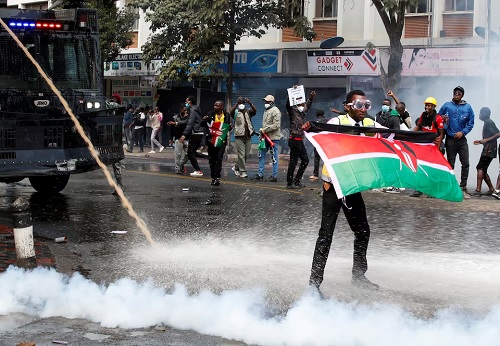adverts
The Kenya Medical Association has reported that five persons have died as a result of a clash between police and protestors.
Earlier, demonstrators over new tax rules broke into the complex housing the Kenyan parliament, setting a portion of the building on fire.
In Nairobi, people have been hearing gunshots and tear gas being fired all day.
adverts
Police have been observed firing tear gas at demonstrators, and some bodies have been spotted on the roadway.
It has been claimed that after passing a finance law that aims to impose extra taxes, several MPs took refuge in the basement of the parliament.
As resentment over the new policies grows, protests are now happening in other regions of Kenya.
On Tuesday, as protestors attempted to storm Kenya’s legislature, police opened fire, killing at least five of them, injuring many more, and setting parts of the parliament building on fire while MPs inside voted tax-hiking legislation.
In disorderly scenes, demonstrators tried to breach the parliament compound by overpowering police and chasing them away. There were flames rising from within.
When water cannons and tear gas failed to break up the masses, police opened fire.
Outside parliament, a Reuters reporter counted the bodies of at least five demonstrators. At least ten people had been shot dead, according to paramedic Vivian Achista.
According to Richard Ngumo, another paramedic, more than fifty persons had been shot. Outside parliament, he was hoisting two injured demonstrators into an ambulance.
As he attempted to enter parliament, protester Davis Tafari told Reuters, “We want to shut down parliament, and every MP should go down and resign.” “We will have a new government.”
Eventually, amid clouds of tear gas and the sound of gunfire, police were able to push the demonstrators out of the premises. According to local media, underground tunnels were used to evacuate the politicians.
During the police crackdown, internet watchdog Netblocks reported that there were significant interruptions to internet services nationwide.
There were also conflicts and protests in a number of other American cities and towns; many of them demanded that President William
Ruto to resign from government and express their disapproval of the tax increases.
The finance bill was adopted by parliament, advancing it to a third reading by legislators. The measure will then be forwarded to the president for signature. If he objects, he can send it back to parliament.
Ruto was elected nearly two years ago on a platform of supporting Kenya’s working poor. However, he is now caught between the demands of a struggling populace and lenders like the International Monetary Fund, which wants the government to reduce deficits in order to get additional assistance.
Kenyans have faced multiple economic setbacks as a result of the COVID-19 pandemic’s aftereffects, the conflict in Ukraine, two years of droughts in a row, and the currency’s depreciation.
The goal of the financial measure is to raise an additional $2.7 billion in taxes in an attempt to reduce the high debt load, which accounts for 37% of yearly revenue in interest payments alone.
In order to allow for discussion, opposition leader Raila Odinga demanded that the Finance Bill be quickly and completely withdrawn.
The government has already given in on certain fronts, pledging to drop plans for further levies on bank transactions, cooking oil, bread, and car ownership. However, demonstrators have not been satisfied with that.
The atmosphere of Tuesday’s rallies was festival-like at first, but as the numbers increased, police in Nairobi’s Central Business District and the impoverished Kibera area opened fire with tear gas. Stones were hurled into police lines by protesters as they sought shelter.
People in the downtown streets scrambled over stalled police cars.
In Eldoret, Ruto’s hometown in western Kenya, where large throngs of protesters crowded the streets and many businesses closed due to fear of violence, police also used tear gas.
Additionally, Eldoret, Ruto’s hometown in western Kenya, saw police use tear gas as protestors crowded the streets and many businesses shuttered for fear of violence.
Along with protests in Kisumu on Lake Victoria and Garissa in eastern Kenya, where police blocked the main road leading to the port of Kismayu in Somalia, there were also clashes in the coastal city of Mombasa.
Crowds in Nairobi sang “Ruto must go” and “All can be possible without Ruto” in Swahili. In the brief hours before the violence worsened, demonstrators waved Kenyan flags and shouted whistles as music played over loudspeakers.
Reuters contacted the police for comment, but they did not reply.
Traditionally, political figures in Kenya who have been open to negotiated settlements and power-sharing arrangements have been the ones to call for protests; however, the youth involved in the present demonstrations lack a formal leader and have been becoming more assertive in their demands.
Initially centred around the budget bill, the protestors’ demands have expanded to include Ruto’s resignation.
Shouting “reject, reject” as the house considered each issue individually, the opposition refused to take part in the vote in parliament. Thereafter, a third and final vote on the bill will be held on the house floor by acclamation.
“They are planning for corruption,” 18-year-old demonstrator Hussein Ali stated. “We are not going to back down. The government is the one who will give in. Not us.


